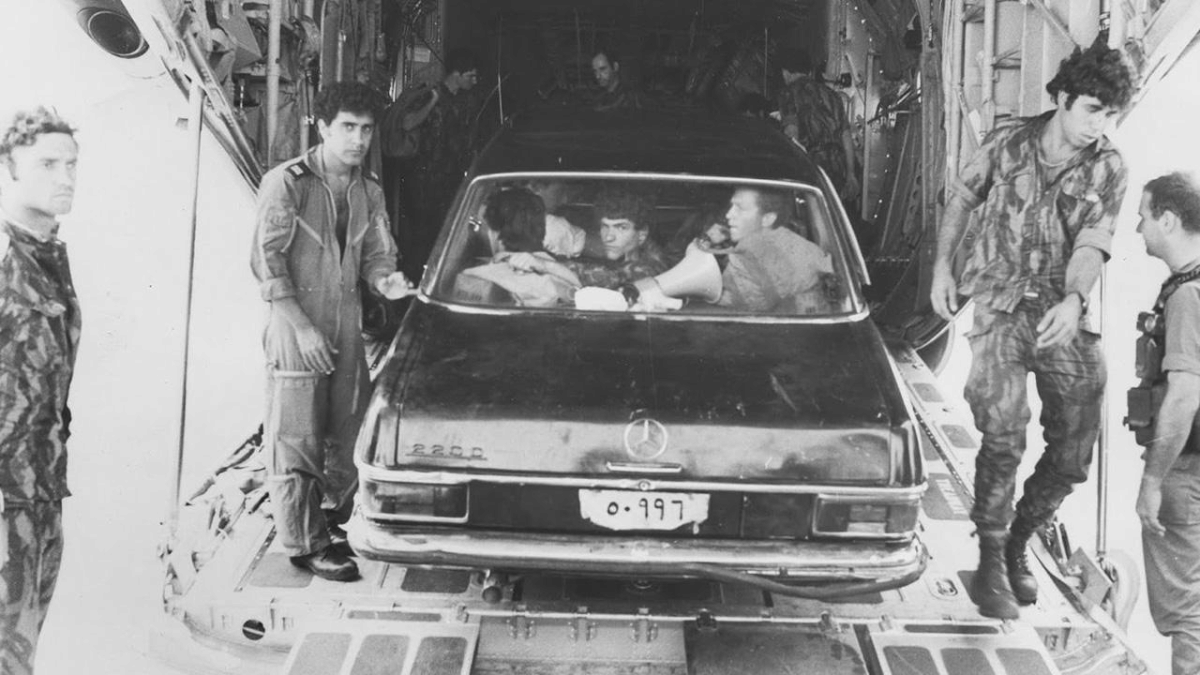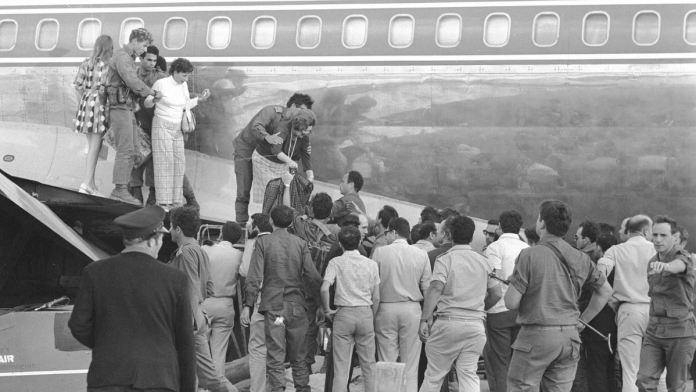New Delhi: July marks a seminal event in Israel’s history that saw the successful rescue of Jewish hostages from Palestinian and German terrorists at the Entebbe International Airport, right under the nose of Ugandan strongman Idi Amin.
The 1976 Entebbe raid, as it is known, however, was not the lone air hijacking that had connection with Israel. Four years earlier, the world watched with bated breath Sayeret Matkal commandos rescue the passengers of Sabena Flight 571. Four terrorists, including two women, were involved in the drama that unfolded at Israel’s Lod Airport, now known as Ben Gurion Airport.
Interestingly, Israel PM Benjamin Netanyahu had taken part as a commando in Operation Isotope in 1972 to rescue the passengers of the Belgian Sabena Airlines plane. In 1976, Netanyahu’s elder brother Colonel Yonatan Netanyahu had pulled off the remarkable hostage rescue in Entebbe at the cost of his life.
The 1976 Operation Entebbe, later renamed Operation Yonatan, cemented the near mythical status of Israel—a nation unwilling to bend to coercion and prepared to bring back its citizens whatever the perils involved.
ThePrint looks at the twin hijacking incidents, the rescue missions, the stakeholders who worked out to bring back the hostages and other related incidents.
Sabena flight 571 hijacking
On 8 May, 1972, four hijackers pretending to be couples—Abed al-Aziz, Ahmed Awad, Theresa Khalsa, and Rima Tannous from ‘Black September’—a Palestinian terrorist group under instructions from Ali Hasan Salameh, nicknamed Red Prince, hijacked Sabena Belgian World Airline flight 571 within 20 minutes after take-off from Vienna.
The Black September members wanted the release of 315 terrorists in exchange for the 97 passengers and crew members.
Captain Reginald Levy, the pilot of the hijacked Belgian airliner, showed extreme cool in a pressure situation, following instructions from terrorists to remain on course and land the plane at Lod Airport outside Tel Aviv.
Not only that, the British pilot is said to calm down the passengers, including his wife Dora, announcing: “As you can see, we have friends aboard.” Unknown to the hijackers, a coded message was already relayed to the Israelis.
Israeli agents using cover of darkness on the same night, creeped under the plane and deflated its tires and disconnected hydraulic equipment, to prevent the terrorists from taking off again.
Defence minister Moshe Dayan, transport minister Shimon Peres, then-chief of military David Elazar gathered at the airport’s control tower to handle the situation. Dayan started negotiations with terrorists and a plan to cover rescue operation simultaneously.
The next day’s assault operation was famously led by Ehud Barak, a Sayeret Matkal commander who later went on to become the Israel prime minister, and Lt. Benjamin Netanyahu, the current prime minister.
Benjamin Netanyahu Injured at a reception for the liberators of the hijacked Sabena plane at the President's residence in Jerusalem 12 May 1972 pic.twitter.com/vArrUwavJ1
— History Hub (@HistoryHubb) September 26, 2024
But it was only after the four hijackers allowed Levy to meet the defence minister to finalise terms of release that the Israelis gathered vital details. Levy provided detailed information about hijackers’ gullibility, positions, the location of explosives, and unsecured emergency exits. The pilot confirmed terrorists having two packages of explosives by providing samples of Semtex explosives sent through him to convince negotiators.
A team of a dozen and a half commandos with Ehud and Netanyahu burst into the plane from five openings—the main door, the rear door, the emergency door and two wings of the plane. Within 10 minutes, two male terrorists were killed and two female hijackers were subdued by the team. Of the two passengers wounded in the raid, one of them died later. Netanyahu was hit non-fatally by a bullet in the operation.
A documentary was released on 11 August, 2015 on ‘Operation Isotope’, the operation to rescue the hijacked Sabena plane, by the film creator and producer Nati Dinner.
Also Read: Iran-Israel conflict: Decades of covert operations and proxy warfare to current confrontation
Operation Thunderbolt
It was a Sunday on 27 June, 1976, when an Air France Flight 139 with 248 passengers took off from Tel Aviv and made a scheduled layover in Athens, Greece, en route to Paris, France.
Soon, four hijackers of the German Baader-Meinhof militant group and the Popular Front for the Liberation of Palestine forced the plane to land in Benghazi, Libya where it was refuelled. Patricia Martell, a British born Israeli citizen, tricked the hijackers into believing that she had a miscarriage and was released.
After refuelling at Libya, the plane reached Entebbe airport, at 3:15 pm local time, on 28 June, more than 24 hours after the original departure. Another four joined the hijackers later.
There, Ugandan President Idi Amin, a professed enemy of Israel, deployed soldiers to secure the airport perimeter. The hijackers then allowed the now-Jewish passengers to leave while the crew and the Jewish and Israeli hostages were held back.
On 30 June, 48 of the non-Israeli hostages–mainly elderly and sick passengers and mothers with children–were released and flown to Paris.
The captors demanded a sum of $5 million and the release of 40 terrorists convicted in Israel, thirteen others imprisoned in four countries within 48 hours. The non-compliance would have led to execution of hostages.
With sketchy information about the situation, the Sayeret Matkal began to prepare for the rescue operation. On 1 July, Israel announced to enter negotiations. The terrorists extended the deadline to 4 July, and released 100 prisoners who flew to Paris, after keeping 105 Jewish and Israeli hostages along with 12-member Air France crew. It gave Israelis a breather.
All plans to convince Idi Amin, including getting him to convince the release of hostages by a retired IDF (Israel Defense Forces) officer, failed. Subsequently, the Entebbe rescue mission was firmed up with help from an Israeli construction firm about the design of the airport.
The non-Jewish released hostages so far had roughly described the hijackers, their weapons, and positioning. Israel operated a small Cessna plane repeatedly over the airport to take photographs.
The mission was complex, risky, and too far from Israel geographically. The raid required support from at least one east African country. The Israelis lacked the logistical capacity to refuel C-130 Hercules in the air. Finally, the Kenyans gave in to the requests for refueling.

The operation began 3 July with the Israeli planes starting their journey to Entebbe, located about 2,500 miles away. The lead Hercules transport plane had two jeeps and a black Mercedes identical to Idi Amin’s personal car. Two additional Hercules carried reinforcements.
Every team was given specific responsibilities. Col. Matan Vilnai was to secure the airport field, while Col. Uri Sagi was tasked with securing the C-130 aircraft for evacuation of the hostages. Major Shaul Mofaz had to destroy Uganda’s fighter jets and to hold off hostile ground forces.
When the Mercedes rolled out of the aircraft, the Israelis were stopped by two alert sentries who were then silenced to prevent the lid from being blown off. The Israeli troops rushed towards the main hall of the airport building. All eight terrorists were killed in six minutes; 3 hostages were also shot in cross fire during the rescue.
Yonatan Netanyahu was killed while five other soldiers were wounded. In the opposing camp, 45 Ugandan soldiers lay dead while 11 MiGs were destroyed on the ground. The operation was complete within 58 minutes as against the plan of 60 minutes.
“A bullet had torn the young heart of one of Israel’s finest sons, one of its most courageous warriors, one of its most promising commanders–the magnificent Yonatan Netanyahu,” Israel defence minister Shimon Peres wrote in an eulogy.
(Edited by Tony Rai)
Also Read: New round of Iran nuclear negotiations begins. Time to talk about Israel’s atomic bombs too






